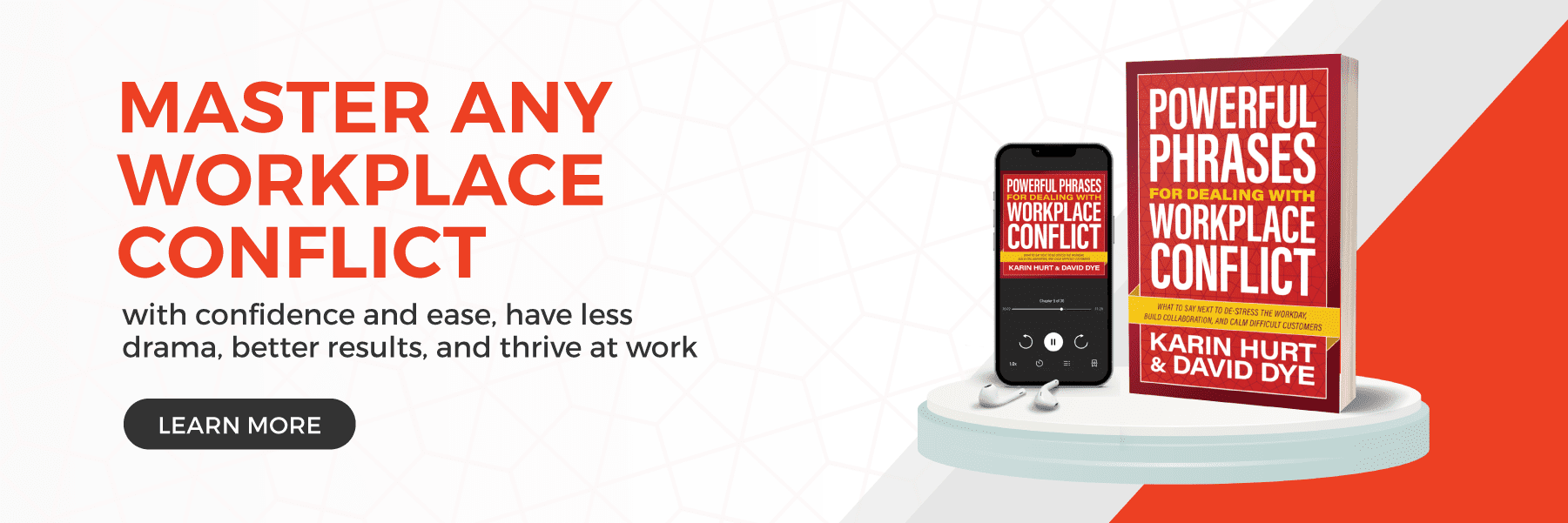Care Enough to Put the Fish on the Table
and Start the Conversation
It’s so tempting to ignore conflict at work. After all, it takes energy and effort to start the conversation.
Sometimes it just feels easier to pretend everything’s good, keep the conversation light, and vent when you get home to anyone who will listen.
But here’s the thing. You can’t improve collaboration if you don’t start the conversation, WITH the actual people involved.
Or as one of our favorite Courageous Cultures clients in Switzerland tells us, “sometimes you just have to put the fish on the table and talk about what’s stinking up the place.”
We know you believe that, because you’re here, investing a bit of time in energy to do this well.
Thank you for your courage and willingness to open the dialogue.
Why It’s So Tempting To Avoid Conflict at Work
There are a variety of reasons people avoid the important conversation they long to have.
One biggie is the lack of connection. A consistent theme across so much research on trust is that connection matters. If you don’t know much about someone, it’s hard to trust them. And, it’s really hard to start a sensitive conversation or address a workplace conflict without trust.
Oddly, the opposite is also true. If you care about someone and your relationship, the stakes might feel too high to bring up a potentially contentious topic. The relationship feels too important to risk losing over this issue, so you do your favorite Elsa (from Frozen) impression and “Let it go.”
Which CAN work, if you actually DO, let it go.
But letting it go is not the same as shoving it down. When too many unspoken concerns pile up, the relationship can quietly degrade. Or worse, everything feels great until it all explodes in one big gush of frustration.
Like that time Uncle Bob threw the Thanksgiving Turkey off the balcony.
And, then, there’s the “last time factor.”
When we ask our clients why they won’t start the conversation they know they need to have, the “last time” factor ranks high on the list.
“The last time I brought this up, he screamed.”
“The last time I tried to address an issue with a co-worker, she spoke badly about me to everyone.”
“Oh, the last time I tried to clarify expectations, I was told to stop being so negative.
In our research on psychological safety and speaking up, we found that often these “last times” weren’t even with players involved in the current conflict, or even at the same company.
Powerful Phrases to Start the Conversation
Here are a few important conversation starters, beginning with the conversation you have with yourself.
Ask yourself
When summoning the courage to surface unspoken conflict, one of the best things you can do is ground yourself in your intention.
Powerful phrases to ask yourself…
“What do I really want to say?”
This one might seem obvious, but conflict can be messy. You might want to say all the things.
Getting clear on your true intention can really help streamline the conversation. Consider what you want the person you’re engaging with to think, feel, or do as a result of your conversation.
“Why does what I have to say matter?”
The famous radio host Bernard Meltzer, is known for offering this sage advice.
“Before you speak ask yourself if what you are going to say is true, is kind, is necessary, is helpful. If the answer is no, maybe what you are about to say should be left unsaid.”
That’s a good screen as you consider whether to start the conversation. If what you have to say is true, kind, and necessary, then it matters. Ground your conversation in that “why.”
“What’s preventing me from saying it?
This is where you get in touch with your own fears and the story you’re telling yourself about what might happen. Are you concerned about “last times?” Are you worried about the relationship? Understanding what’s holding you back can help ground your message.
For example, if you’re concerned about the relationship, you might begin there.
“I’m hesitant to bring this up because I know it could be upsetting. The thing is, I care too much about our relationship and the work we’re doing together to not talk about this…”
“What’s at stake if I stay silent?
Dr. Amy Edmondson, the pioneer of psychological safety, often talks about how people are more likely to “discount the future” benefits of speaking up, and overweight their current fear.
When you ask yourself this powerful question, you consider the future and the risks of staying silent.
Martin Sheen is known for sharing this poignant Irish tale
A man who arrives at the gates of heaven and asks to be let in St. Peter says, “Of course, just show us your scars.” The man says, “I have no scars”. St. Peter says, “What a pity was there nothing worth fighting for”?
“What might be causing others to default to silence?”
Of course, you can’t know for sure if you don’t ask, but you might have some hunches. One approach could be to “put the fish on the table” in this way.
“I’m concerned that we might not be talking about _________. And my hunch is that’s because of _________. Here’s why I thnk we need to have the conversation anyway. What do you think?
“What’s the worst thing that can happen here?”
That final question can be strangely empowering. One of our clients, a US Marine veteran is fond of saying. “When I get too stressed about a conflict, I just remember, no one is shooting at me.”
Get Curious: Invite Others Into the Conversation
Once you’ve grounded yourself in your intention, it’s time to get curious. Here are a few powerful phrases that can help start the conversation.
- “What’s one issue we’re not talking about that would make all the difference in our effectiveness?”
- “I’m sensing that there’s something important we’re not talking about, do you feel that way too?”
- “I’ve noticed ________ (insert concern here). I’d love to brainstorm ways we could address this.”
- “Let’s put the fish on the table (or ditch the diaper genie) and talk about what’s really going on here.”
Or Try Visible Anonymity
If asking these questions directly feels overly intimidating for you (or for them), another approach is to surface people’s candid feelings using a visible anonymity technique. Visible anonymity means you ask a question, and everyone can tell people are answering, but they don’t know who said what.
If you’re physically in the same room, one easy way to do this is to hand out index cards and invite people to share their hopes and concerns. Then you collect the cards, read them aloud, and discuss them.
Some examples we use all the time using the Index card approach to start the conversation:
- “What are your biggest hopes for this project?”
- “What are your biggest fears for this project?”
OR…
- “What are you most looking forward to in the next six months?” (this is a great one to create connection and common ground).
- “What are your biggest concerns for the next six months?”
If you’re working in a remote team, you can achieve a similar outcome, with a quick anonymous survey.
We do this all the time in the “Asking for a Friend” segment in our leadership development programs. In between sessions, we use our Let’s Grow Leaders Learning Lab (micro-learning tool) to invite people to ask any question they might be reluctant to ask in the live program. 
It works great in panel discussions too. You can invite employees to raise important questions to a panel of your leaders on simple “Asking for a Friend” cards you scatter on the tables and then collect.
It’s amazing how eager people are to share what’s on their hearts and minds, and we can easily surface the conversations that need to happen and discuss tangible solutions.
Finding the courage to start an uncomfortable conversation can be tricky, but when you ground yourself in connection and intention, you’ll likely save everyone from bigger angst and frustration in the future.
Related Articles:
12 Powerful Phrases to Navigate Challenging Workplace Conflict
How to Host a Clear-the-Air Meeting for Better Team Collaboration








0 Comments